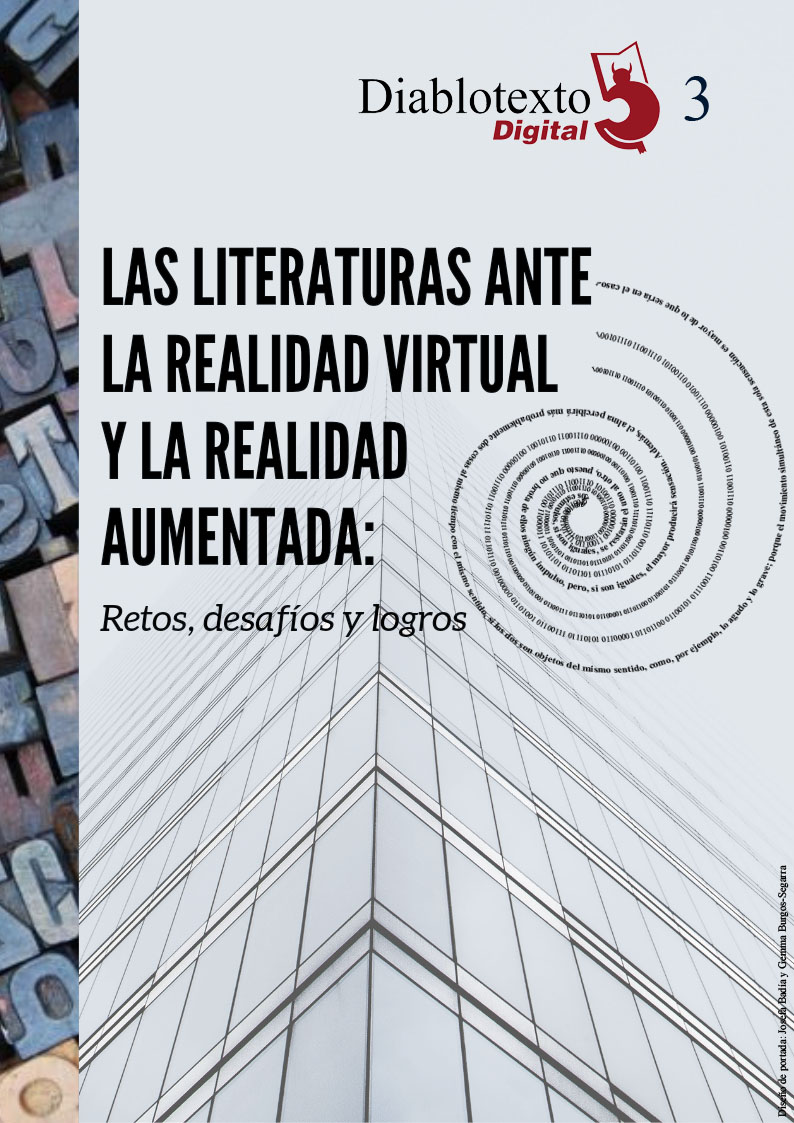The Immaterial Nature of the Lyric: Eduardo Kac’s Holopoetry
DOI:
https://doi.org/10.7203/diablotexto.3.13092Keywords:
Holopoetry, Eduardo Kac, Lyric, Digital Poetry Abstract
Abstract
Holopoetry explores the boundaries of space and reception and stands as a tridimensional, non-material lyric. Eduardo Kac’s work pioneers the genre, not only by his theoretical texts, but more importantly for his artistic creations. The lecture of holographic poems can only be conceived in terms of the lecturer’s point of view, with their approach to the work and its own motion. Thus, the constantly changing text becomes an event developed in both the spatial and temporal categories and generates a remarkably new aesthetic experience, mutable and different from one spectator to another.
 Downloads
Downloads
 References
References
Augé, Marc (2004). Los no lugares. Barcelona: Gedisa.
Baudrillard, Jean (1993). Cultura y simulacro. Barcelona: Kairós.
Baudrillard, Jean (2000). Pantalla total. Barcelona: Anagrama.
Bauman, Zygmund (2003). La modernidad líquida. México D.F.: Fondo de Cultura Económica.
Borsuk, Amaranth; Bouse, Brad (2012). Between Page and Screen. http://news.cnet.com/8301-17938_105-57373708-1/digital-pop-up-book-gets-poetic-with-qr-codes/ [Fecha de consulta: 31-10-2018].
Corral Cañas, Celia (2015). Nuevos ámbitos en la creación de arte verbal. Poesía española contemporánea en la red. Salamanca: Universidad de Salamanca, Tesis y disertaciones académicas (Tesis doctoral). Disponible en http://hdl.handle.net/10366/127372
Deleuze, Gilles; Guattari, Félix (2010). Rizoma. Introducción. Valencia: Pre-Textos, 2010.
Foucault, Michael (1986). “Of other spaces.” Diacritics, 16, pp. 22-27.
Gache, Belén (2006). Escrituras nómades. Gijón: Trea.
Giovine Yáñez, María Andrea (2004). “Poesía perceptual: experiencias poéticas interactivas”, Revista laboratorio, 9. http://revistalaboratorio.udp.cl/num9_2014_art3_giovine/ [22-09-2018].
Husárová, Zuzana; Panák L'ubomír (2011). Enter:in ‘Wodies. Vimeo http://vimeo.com/29835469 [Fecha de consulta: 31-10-2018].
Huizinga, Johan (1972). Homo ludens. Madrid: Alianza.
Johnston, David (2011). Aesthetic Animism: Digital Poetry as Ontological Probe. Montreal: Concordia University, Tesis y disertaciones académicas (Tesis doctoral). Disponible en https://spectrum.library.concordia.ca/36284/
Kac, Eduardo (2015). “Confluencias artísticas en la holopoesía y la poesía digital”, Simposio Internacional Máquinas de Inminencia: Estéticas de la Literatura Electrónica, Centro Cultural Universitaria, 8 y 9 de octubre de 2015, Plataformas de la imaginación i escenarios de la literatura electrónica, México, Laboratorio de literaturas extendidas y otras materialidades, YouTube, 9 de diciembre de 2017. https://www.youtube.com/watch?v=aDg_4S-a3cc [Fecha de consulta: 22-09-2018].
Kac, Eduardo (1997). “Holopoesía y más allá”, Vórtice argentina. http://www.vorticeargentina.com.ar/poesiavisual/escritos/holopoesia_y_mas_alla.html [Fecha de consulta: 22-09-2018].
Kac, Eduardo. KAC. http://ekac.org/ [Fecha de consulta: 22-09-2018].
Lewis, Jason Edward. P.o.E.M.M. (Poems for Excitable [Mobile] Media). http://www.poemm.net [Fecha de consulta: 22-09-18].
Lipovetsky, Gilles (1990). El imperio de lo efímero. Barcelona: Anagrama.
Maffesoli, Michel (2001). El instante eterno. El retorno de lo trágico en las sociedades posmodernas. Buenos Aires: Paidós.
McLuhan, Marshall (1988). El medio es el mensaje. Barcelona: Paidós Studios.
Molinuevo, José Luis (2006). La vida en tiempo real. La crisis de las utopías digitales. Madrid: Biblioteca Nueva.
Mora, Vicente Luis (2012). El lectoespectador. Barcelona. Seix Barral.
Vega, María José (2002). “Holopoemas. La palabra ilusoria”, Quimera, número 220, pp. 55-58.
Vilariño Picos, María Teresa (2006). “Redefiniendo la poesía experimental: la holopoesía de Eduado Kac”. En Dolores Fernández López y Fernando Rodríguez-Gallego (coords.), Haciendo camino en la investigación literaria, Santiago de Compostela: Universidad de Santiago de Compostela, pp. 105-114.
Downloads
Published
How to Cite
-
Abstract389
-
PDF (Español)501
Issue
Section
License
Licencia de reconocimiento de Creative Commons “Reconocimiento - No Comercia l- Sin Obra Derivada
Authors who publish with this journal agree to the following items:
The authors will keep their copyright and guarantee the journal the right of first publication of their work, which will be simultaneously subject to the Creative Commons license that allows third parties to share the work indicating its author and its first publication in the journal. The authors may adopt other non-exclusive license agreements to distribute the version of the published work (e.g., depositing it in an institutional telematic file or publishing it in a monographic volume), with an acknowledgment of its initial publication in this journal. The authors are allowed and encouraged to disseminate their work through the Internet (e.g., in institutional telematic archives or on their website) before and during the submission process, which can produce interesting exchanges and increase citations of the published work. (See Effect of Open Access)




